1statistics (2).ppt and probabilty for grade 11
- 1. COURSE CONTENT • Basic Terms in Statistics • Sampling Techniques • Measures of Central Tendency • Measures of Variability • Test of Hypothesis
- 2. STATISTICS is a branch of mathematics that deals with the collection, organization, presentation, analysis, and interpretation of data. is a collection of methods for planning experiments, obtaining data, and then organizing, summarizing, presenting, analyzing, interpreting, and drawing conclusions based on the data.
- 3. STATISTICS Collection Collection refers to the gathering of information or data. Organization Organization or presentation presentation involves summarizing data or information in textual, graphical or tabular form. Analysis Analysis involves describing the data using statistical methods and procedures. Interpretation Interpretation refers to the process of making conclusions based on the result of the statistical treatment of the data.
- 4. Branches of Statistics DESCRIPTIVE Statistics - summarize or describe the important characteristics of a known set of population data INFERENTIAL Statistics - use sample data to make inferences (or generalizations) about a population
- 5. Classify the following statements as belonging to the area of descriptive or inferential statistics? 1. According to a recent survey, most fourth year students are still undecided on what course to pursue in the tertiary education. 2. About 45% of the students are unsatisfied during the recently held JS Promenade. 3. A politician would like to estimate, based on an opinion poll, his chances of winning in the national elections. 4. The school principal predicts the passing rate of this year’s National Achievement Test (NAT) based on the results of the examination during the last three years. 5. A teacher wants to know the effectivity of using educational technologies in classroom teaching.
- 6. Population vs. Sample • A POPULATION POPULATION is a complete collection of all elements (scores, people, measurements) to be studied. • A SAMPLE SAMPLE is a portion/sub-collection of elements drawn from a population.
- 7. • A PARAMETER PARAMETER is a numerical measurement describing some characteristics of a population. • A STATISTIC STATISTIC is a numerical measurement describing a characteristic of a sample. Parameter vs. Statistic
- 8. • QUALITATIVE DATA QUALITATIVE DATA (categorical) can be separated into different categories that are distinguished by some nonnumeric characteristics. • QUANTITATIVE DATA QUANTITATIVE DATA (numerical) consist of numbers representing counts or measurements. Qualitative vs. Quantitative Data
- 9. 1. Gender 2. Age 3. Number of Family Members 4. General Weighted Average in High School 5. Type of School A student was asked to accomplish a form on his or her personal data prior to his or her admission to a certain university. Determine whether the following information can be classified as qualitative or quantitative.
- 10. • DISCRETE DATA DISCRETE DATA result from either a finite number of possible values or countable number of possible values as 0, or 1, or 2, and so on. • CONTINUOUS DATA CONTINUOUS DATA result from infinitely many possible values that can be associated with points on a continuous scale in such a way that there are no gaps or interruptions. Discrete vs. Continuous Data
- 11. 1. Number of students engaged in sports 2. Memory capacity of a computer 3. Body temperature 4. Ages of fourth year students 5. Number of teachers in Pamplona Institute 6. Grade in Mathematics 7. Number of books in the shelf 8. Time consumed in taking a math exam 9. Distance traveled by a car 10. Dale’s height Quantitative data can be classified further as discrete or continuous data. Determine whether the following is a discrete discrete or continuous continuous data.
- 12. • DEPENDENT VARIABLE DEPENDENT VARIABLE – the variable that is being affected or explained • INDEPENDENT VARIABLE INDEPENDENT VARIABLE – the variable that affects or explains Dependent vs. Independent Variable
- 13. 1. Television Cartoon Characters as Visual Aids: Its Effect on the Preschoolers’ Verbal Interaction and Letter Identification Skills 2. The Effectiveness of Practical Work as an Approach to the Teaching of Contemporary Mathematics 3. Enhancing Students’ Understanding of the Properties of Graphs of Polynomial Functions Through Microsoft Math Software Determine the independent independent and dependent dependent variable in the following researches/studies.
- 14. • The nominal level of measurement nominal level of measurement is characterized by data that consist of names, labels, or categories only. • The ordinal level of measurement ordinal level of measurement involves data that may be arranged in some order but differences between data values either cannot be determined or are meaningless. Levels of Measurement
- 15. • The interval level of measurement interval level of measurement is like the ordinal level, but meaningful amounts of differences can be determined. It has no inherent (natural) zero starting point. • The ratio level of measurement ratio level of measurement is the interval level modified to include the inherent zero starting point. Levels of Measurement
- 16. 1. Blood type of a patient admitted to a hospital 2. Intelligence Quotient of a student 3. Tax identification number (TIN) of an employee 4. A student’s academic rank in high school 5. Average daily sales of a bakeshop 6. TV network most preferred by students 7. Most popular movie actor 8. Birth order in the family 9. Body temperature 10. Memory capacity of a computer Identify the level of measurement for each of the following data.
- 17. Collection of Data Classification of Data 1. 1.Primary Data Primary Data includes information collected from original source of data, which is firsthand in nature. 2. 2.Secondary Data Secondary Data includes information collected from published or unpublished sources such as books, newspapers, and theses.
- 18. Guidelines in Data Collection 1. Questions must be phrased simply and clearly to yield accurate results and higher response rates. 2. To ensure accuracy, it is better to take actual measurements than merely asking respondents for a value. 3. Choose a method of data collection that will produce high response rates. The type of data collection procedure employed may affect the speed of data collection. 4. Ensure that the sample size is large enough for the required purposes. 5. Ensure that the method used to collect data actually results in a sample that is representative of the population.
- 19. Data Collection Methods DIRECT METHOD – is often referred to as interview method. This is a face-to-face encounter between the interviewer and the interviewee. INDIRECT METHOD – is popularly known as the questionnaire method. This method is done by giving prepared relevant questionnaires to the respondents of the study from which one would like to get the needed information. REGISTRATION METHOD – It is a method of utilizing the existing data or fact or information, which is kept systematized by the office concerned. These are being enforced by certain laws.
- 20. Data Collection Methods OBSERVATION METHOD – is used to collect data pertaining attitudes, behavior, values, and cultural patterns of the samples under investigation. EXPERIMENT METHOD – is used if the researcher would like to determine the cause and effect relationship of certain phenomena under investigation. PUBLISHED SOURCE
- 21. Data Collection Methods 1. Direct Method or Interview 2. Indirect Method or Questionnaire 3. Published Source 4. Experimentation 5. Observation 6. Registration
- 22. Slovin’s Formula ___N___ ___N___ n = n = 1 + Ne 1 + Ne2 2 Where: n = sample size N = population size e = margin of error
- 23. The slovin’s formula is used to determine the appropriate sample size (or the number of respondents or required data). 1. Matucay NHS has 969 students this school year. Find the sample size at 0.05 margin of error. 2. Cagayan has a population of 980 000. Find the sample size at 0.01 margin of error.
- 24. • is the process of careful selection of members of a population to study and make generalizations about a population. Sampling
- 25. Probability Sampling Method Probability Sampling Method 1. Simple Random Sampling 2. Systematic Sampling 3. Stratified Random Sampling 4. Cluster Sampling Non-probability Sampling Method Non-probability Sampling Method 1. Convenience Sampling 2. Snowball Sampling 3. Modal Instance Sampling Sampling Techniques
- 26. • is a method of sampling where each member of the population has an equal chance of being selected as a part of the sample. • The most common techniques are by drawing lots, using printed tables of random numbers or using numbers generated by computers. Simple Random Sampling
- 27. • is a method of sampling where each sample is taken by selecting a member of a population on a periodic interval. • Choose an starting point and then select every kth element (such as every 3rd ) element in the population. Systematic Sampling
- 28. • is a method of sampling where the population is divided into homogeneous subgroups called strata strata and then a simple random sample is taken from each of the subgroups. Stratified Random Sampling
- 29. • Divide the population area into sections (or clusters) and randomly select a few of those sections, and finally, choose all the members from the selected sections. Cluster Sampling
- 30. • Is a non-random sampling of choosing samples which is based on a certain criteria and rules laid down by the researcher. Purposive Sampling
- 31. • A non-random sampling in which the researcher limits the number of his samples based on the required number of the subject under investigation. Quota Sampling
- 32. • is a non-probability sampling procedure where the members of the sample are determined based on convenient availability, proximity or accessibility to the researcher. Convenience Sampling
- 33. • is a non-probability sampling method where a member of the sample is chosen through referral of the other members of the sample. Snowball Sampling
- 34. • is a method of non-probability sampling where the members of the sample are selected based on the typical, most frequent observation or modal cases. Modal Instance Sampling
- 35. 1. A reporter who wishes to interview five senators writes the name of each senator on a separate cards, and then draws five names. 2. A market researcher obtains a sample data from people who chose to respond to an online survey posted on the company’s website. Identify the type of sampling used in each statement.
- 36. 3. A program director gathers information from all students belonging to each of the five classes selected randomly from a total of 20 classes. 4. A telemarketer sets the company’s computerized dialing system to contact every 40th person listed in the telephone directory. Identify the type of sampling used in each statement.
- 37. 5. A marketing officer mailed a survey to a total of 300 members of a fitness club. The sample included 100 members randomly selected from each membership classifications, such as full membership, lifetime associate membership and yearly membership. Identify the type of sampling used in each statement.
- 38. 6. An actress is preparing for the role of a young female who has recovered from a severe drug addiction. She decided to get information from people who have been in such a case. The actress looked for a reliable person who can refer her to somebody who has recovered from the same addiction. Identify the type of sampling used in each statement.
- 39. 7. A real estate agent is looking for possible buyers of a condominium unit located at a business district in a certain city. He went to a mall and distributed flyers to those whom he thinks can afford the condominium unit’s high cost. He identified possible buyers based on their physical appearance and manner of dressing. 8. An engineer selects every 50th item from the assembly line for careful testing and analysis. Identify the type of sampling used in each statement.
- 40. 9. A John Hopkins University researcher surveys all cardiac patients in each of 30 randomly selected hospitals. 10. A General Motors researcher has partitioned all registered cars into categories of subcompact, compact, mid-size, intermediate and full-size. He is surveying 200 randomly selected car owners from each category. Identify the type of sampling used in each statement.
- 41. Methods of Data Organization 1. 1. Textual Method Textual Method (paragraph form) – important characteristics of the data are given emphasis. 2. 2. Tabular Method Tabular Method (frequency distribution table or FDT) – shows the groupings of the data into number of classes (intervals). 3. 3. Graphical Method Graphical Method (chart) – visual representation of the frequency distribution.. Presentation of Data
- 42. Textual Method (Paragraph Form) TV Network Votes Relative Frequency ABS-CBN 2 15 200 30.4 GMA 7 17 000 34.0 TV 5 14 500 29.0 Other Networks 3 300 6.6 TOTAL 50 000 100 Table 1 shows that 34% of the respondents or 17 000 of the 50 000 respondents voted for GMA 7 as their favorite TV Network. ABS-CBN 2 and TV 5 got 30.4% and 29% of the votes, respectively. Three thousand three hundred respondents or 6.6% of the votes goes to other networks. This implies that GMA 7 is still the number one TV Station in the Philippines.
- 43. Lists data values (either individually or by groups of intervals) along with their corresponding frequencies or counts Frequency Distribution Table
- 44. 1. Table heading – contains the table number and title, ad serves as guide on the content of the table. 2. Body – contains the information and is essential part of the table 3. Classes or categories – tells about the row classification of the data 4. Caption – provides column identification or heading 5. Source or reference note – written below the table to indicate the name of the agency or person whom the information was taken from. Parts of a Frequency Distribution Table
- 45. Example of a Frequency Distribution Table Table 1. Enrollment Profile of Pamplona Institute, SY 2010-2011 Year Level Number of Students First Year 100 Second Year 98 Third Year 90 Fourth Year 84 TOTAL 372 * Registrar’s Office
- 46. Steps in Constructing Frequency Distribution Table 1. Arrange the data set in an array. 2. Find the range. (R = HOV – LOV) 3. Decide on the number of classes. (5-15) 4. Compute for the class width/class size. ( i = R/ number of classes) 5. Set up the classes starting from the lowest class limit. 6. Construct column for the frequencies.
- 47. Lower Class Limits are the smallest numbers that can actually belong to different classes X Frequency 5-8 11 9-12 12 13-16 14 17-20 1 21-24 2
- 48. Upper Class Limits are the largest numbers that can actually belong to different classes X Frequency 5-8 11 9-12 12 13-16 14 17-20 1 21-24 2
- 49. Class Boundaries are the numbers used to separate classes, but without the gaps created by the class limits X Frequency 5-8 11 9-12 12 13-16 14 17-20 1 21-24 2 4.5 8.5 12.5 16.5 20.5
- 50. Class Marks/ Class Midpoints These can be found by adding the lower class limit to the upper class limit and dividing the sum by two. X Frequency 5 -8 11 9 -12 12 13 -16 14 17 -20 1 21 -24 2 6.5 10.5 14.5 18.5 22.5
- 51. Class Width/ Class Size The difference between any two consecutive lower class limits or two consecutive lower class boundaries. X Frequency 5-8 11 9-12 12 13-16 14 17-20 1 21-24 2 4 4 4 4 4
- 52. Relative Frequency (RF) The proportion of observations that falls on a certain interval; it is usually expressed in percentage. X Frequency Relative Frequency 5-8 11 27.5 9-12 12 30 13-16 14 35 17-20 1 2.5 21-24 2 5 n 40 100
- 53. Cumulative Frequency (CF) The accumulated frequency of the classes. Less than CF (<CF) – the accumulated observations not exceeding the upper limit of a class Greater than CF (>CF) – the accumulated observations that are at least the lower limit of the class X Frequency <CF >CF 5-8 11 11 40 9-12 12 23 29 13-16 14 37 17 17-20 1 38 3 21-24 2 40 2 n 40
- 54. Relative Cumulative Frequency (RCF) The accumulated frequency of the classes in percentage. X Frequency Relative Frequency <RCF >RCF 5-8 11 27.5 27.5 100 9-12 12 30 57.5 72.5 13-16 14 35 92.5 42.5 17-20 1 2.5 95 7.5 21-24 2 5 100 5 n 40 100
- 55. GRAPHS AND CHARTS A good graph is a visual representation of data in a clear, accurate, and simple manner. It provides opportunity to perform data comparisons without misleading the reader; thus, it does not distort the data. Pie charts, bar graphs, and Pareto charts are appropriate to use for presenting categorical data sets. On the other hand, line graphs, histograms, frequency polygons, and ogives are best for numerical data sets. For bivariate data sets, contingency tables, side-by-side bar graphs, and multiple line graphs are used.
- 56. Pie Chart It is used to show how all the parts of something are related to the whole. It is represented by a circle divided into slices or sectors of various sizes that show each part’s relationship to the whole and to the parts of the circle.
- 57. Bar Graph Is a graph which uses horizontal or vertical bars to represent data. When a bar graph has bars which extend from left to right, it called a horizontal bar graph. On the other hand, if the bars extend from top to bottom, it is called a vertical bar graph. A side-by-side bar graph is a special type of bar graph that allows comparison of two sets of information for each category.
- 58. Line Graph Is used to represent changes in data over a period of time. Data are represented by points and are joined by line segments. Multiple line graphs are also used to present bivariate data as an alternative to side-by-side bar graph.
- 59. Histogram Consists of a horizontal scale of values of the data being represented, a vertical scale for frequencies, and bars representing the frequency for each subdivision of class values.
- 60. Pareto Chart Is a bar graph for categorical data with bars arranged in descending order of frequencies.
- 61. Ogive Is a graph in which a point is plotted above each class boundary at a height equal to the cumulative frequency corresponding to that boundary.
- 62. Frequency Polygon Is a line graph constructed by plotting the class marks at a height equal to the frequency corresponding to that class mark. The points are connected to form the polygon.
- 63. Contingency Table Or a cross-classification table is used to simultaneously present data of at least two variables (usually categorical).
- 64. Pictograph Is a graph that uses pictures to illustrate data.
- 65. MEASURES OF CENTRAL TENDENCY (UNGROUPED DATA)
- 66. The MEAN • Simple Arithmetic Mean (Average) • Weighted Mean
- 68. TESTS of Hypothesis Hypothesis Hypothesis A statement or tentative theory which aims to explain facts about the real world. An educated guess It is subject for testing. If it is found to be statistically true, it is accepted. Otherwise, it gets rejected.
- 69. Kinds of Hypotheses 1.Null Hypothesis (Ho) 1.Null Hypothesis (Ho) It serves as the working hypothesis. It is that which one hopes to accept or reject. It must always express the idea of no significant difference. 2. Alternative Hypothesis (Ha) 2. Alternative Hypothesis (Ha) It generally represents the hypothetical statement that the researcher wants to prove.
- 70. Types of Alternative Hypotheses (Ha) 1. Directional Hypothesis 1. Directional Hypothesis Expresses direction One-tailed Uses order relation of “greater than” or “less than” 2. Non-directional Hypothesis 2. Non-directional Hypothesis Does not express direction Two-tailed Uses the “not equal to”
- 71. Type I and Type II Errors A Type I error Type I error is the mistake of rejecting the null hypothesis when it is true. The symbol α α (alpha) is used to represent the probability of a type I error. A Type II error Type II error is the mistake of failing to reject the null hypothesis when it is false. The symbol β β (beta) is used to represent the probability of a type II error.
- 72. Level of Significance The probability of making Type I error or alpha error in a test is called the significance level significance level of the test. The significance level of a test is the maximum value of the probability of rejecting the null hypothesis (Ho) when in fact it is true.
- 73. Critical Value A critical value critical value is any value that separates the critical region (where we reject the null hypothesis) from the values of the test statistic that do not lead to rejection of the null hypothesis, the sampling distribution that applies, and the significance level α.
- 74. P-Value The P-value P-value (probability value) is the probability of getting a value of the test statistic that is at least as extreme as the one representing the sample data, assuming that the null hypothesis is true. The null hypothesis is rejected if the P-value is very small, such as 0.05 or less.
- 75. Steps in Hypothesis Testing 1. Formulate the null hypothesis (Ho) that there is no significant difference between the items compared. State the alternative hypothesis (Ha) which is used in case Ho is rejected. 2. Set the level of significance of the test, α. 3. Determine the test to be used. Z-test Z-test – used if the population standard deviation is given T-test T-test – used if the sample standard deviation is given
- 76. Steps in Hypothesis Testing 4. Determine the tabular value of the test For a z-test, the table below summarizes the critical values at varying significance levels. Types of Test Level of Significance 0.10 0.10 0.05 0.05 0.025 0.025 0.01 0.01 One-tailed ± 1.28 ± 1.645 ± 1.96 ± 2.33 Two-tailed ± 1.645 ± 1.96 ± 2.33 ± 2.58
- 77. Steps in Hypothesis Testing 4. Determine the tabular value of the test For a t-test, one must compute first the degree/s of freedom (df) then look for the tabular value from the table of Students’ T-distribution. For a single sample df = n – 1 For two samples df = n1 + n2 - 2
- 78. Steps in Hypothesis Testing 5. Compute for z or t as needed. Vary your solutions using the formulas: For z-test i. Sample mean compared with a population mean ii. Comparing two sample means iii. Comparing two sample proportions For t-test i. Sample mean compared with a population mean ii. Comparing two sample means
- 79. Steps in Hypothesis Testing 6. Compare the computed value with its corresponding tabular value, then state your conclusions based on the following guidelines: Reject Ho Reject Ho if the absolute computed value is equal to or greater than the absolute tabular value. Accept Ho Accept Ho if the absolute computed value is less than the absolute tabular value.
- 80. Decision Criterion Traditional Method: Reject Ho Reject Ho (accept Ha) if the test statistic falls within the critical region Fail to reject Ho Fail to reject Ho (accept Ho) if the test statistic does not fall within the critical region
- 81. Decision Criterion P-value Method: Reject Ho Reject Ho (accept Ha) if P-value ≤ α ( where α is the significance level, such as 0.05) Fail to reject Ho Fail to reject Ho (accept Ho) if P-value > α
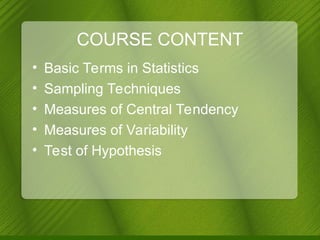
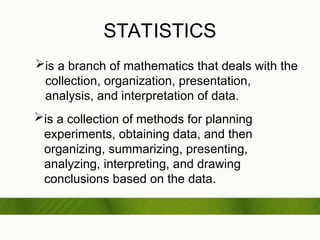
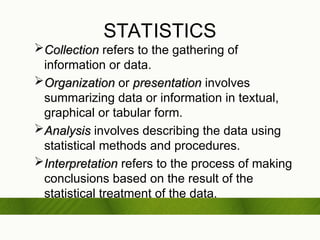
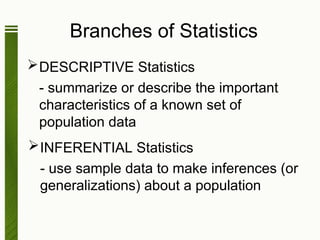
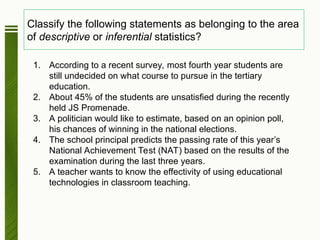
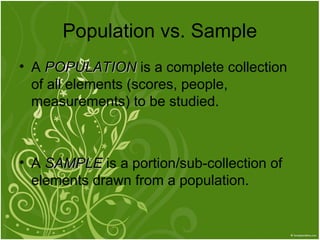
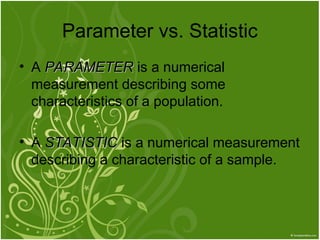
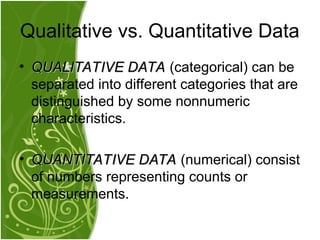
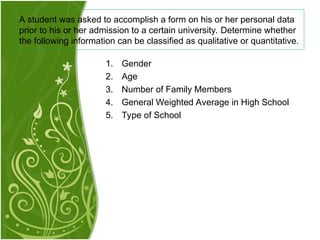


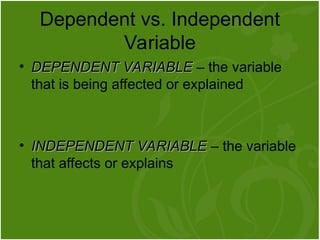
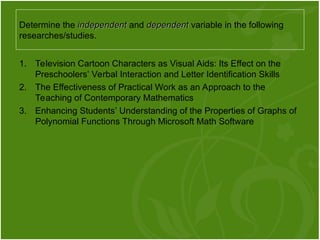

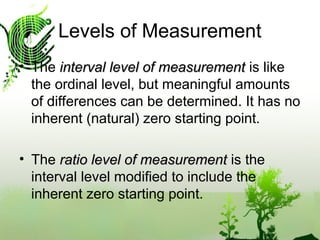
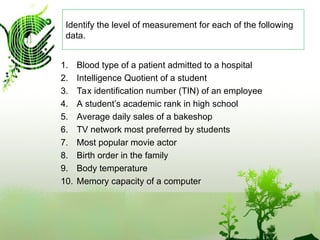

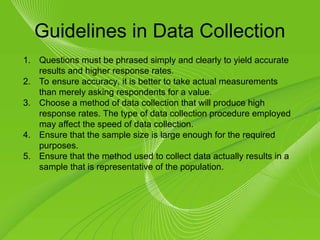
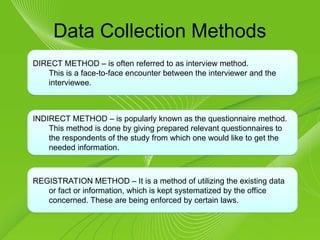

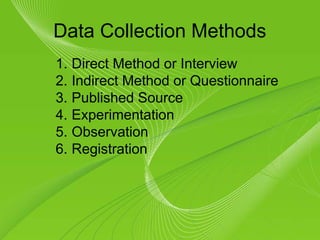
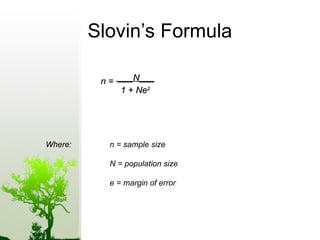

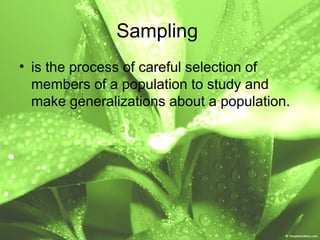

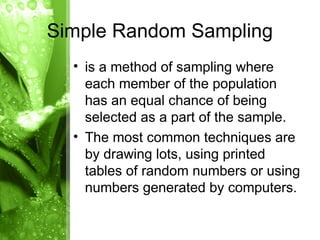
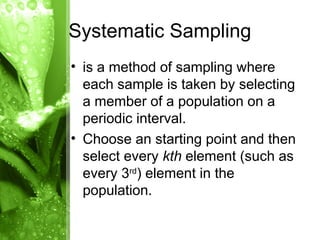
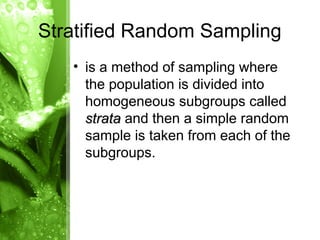
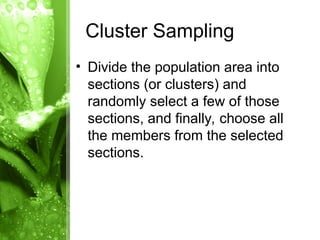
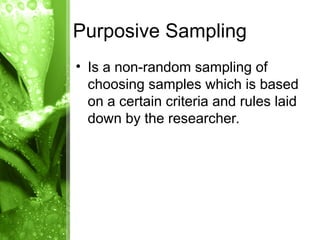

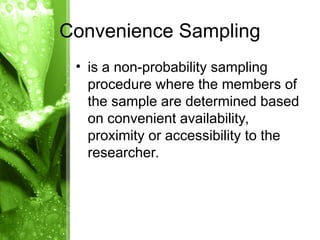
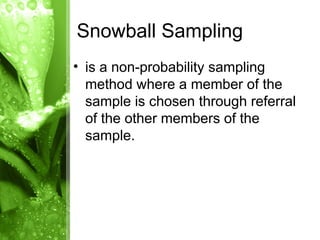


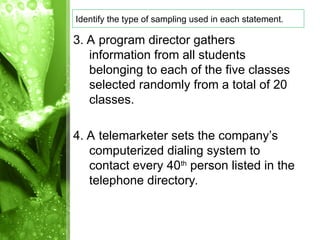
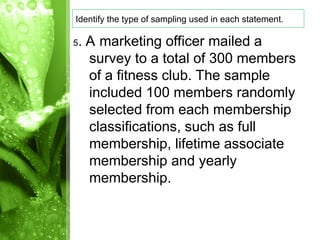
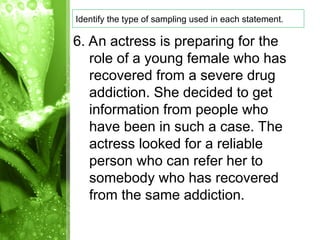


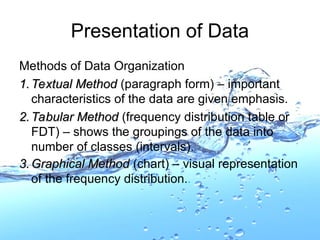


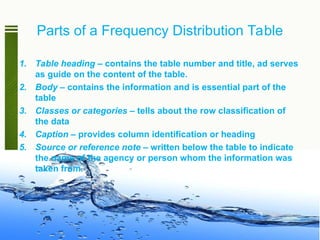
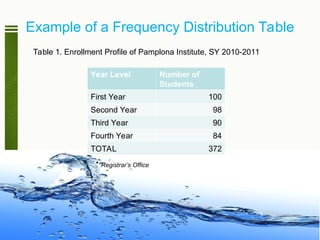
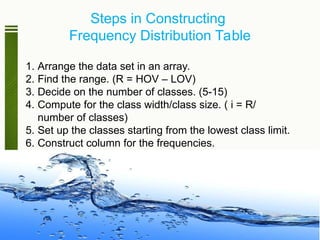
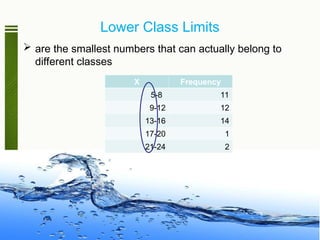
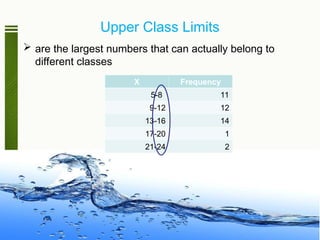
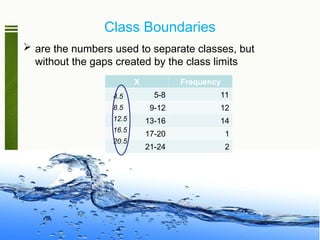
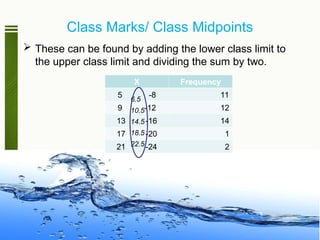
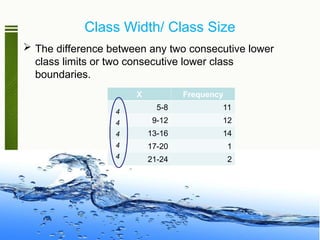
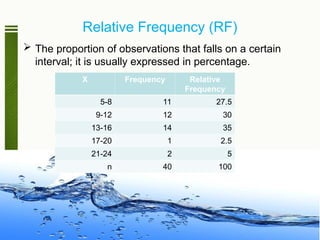
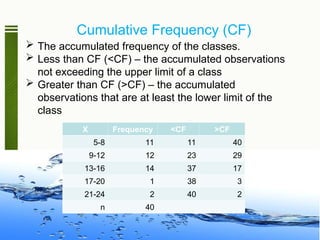
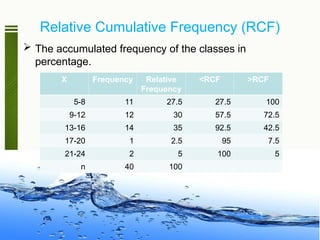
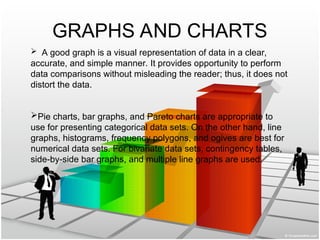
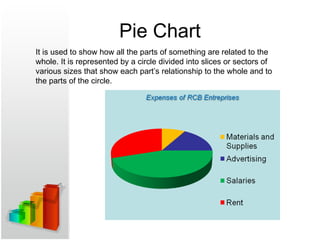
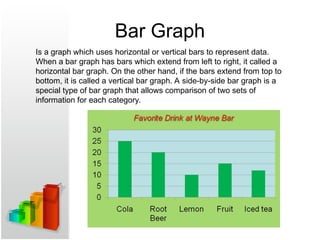

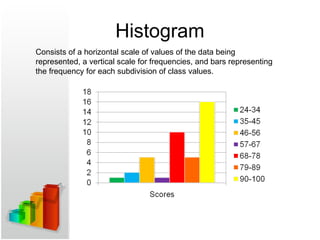
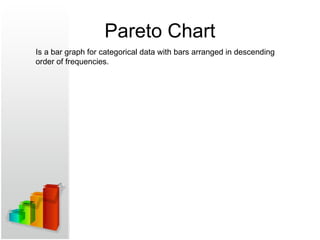
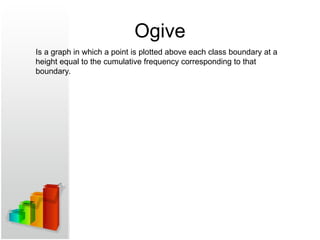

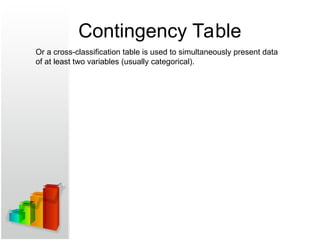




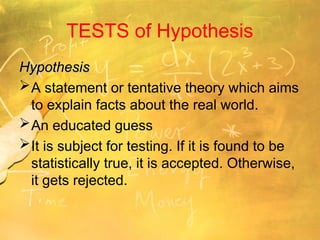
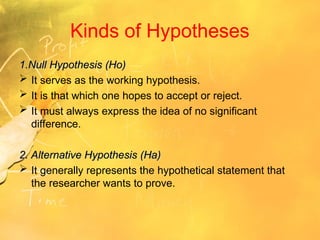
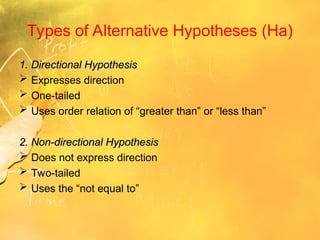
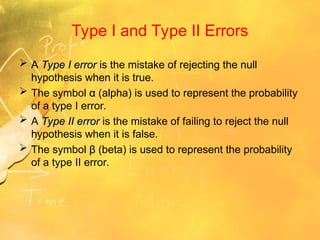
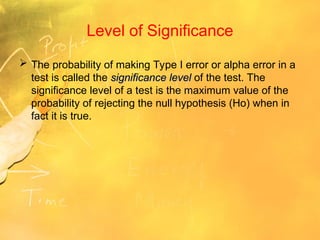
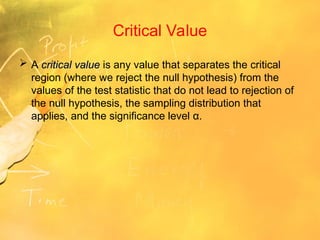
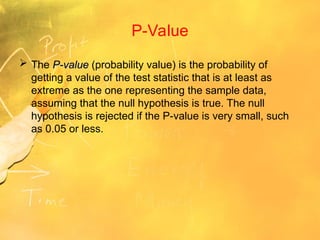
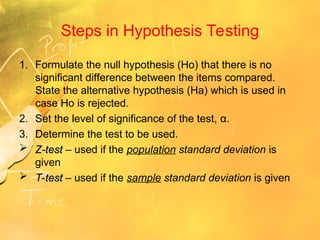
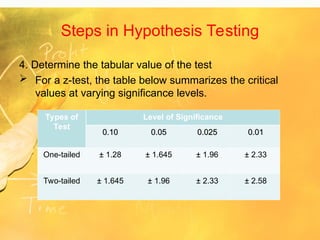
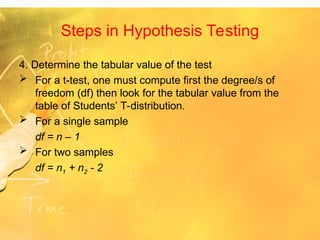
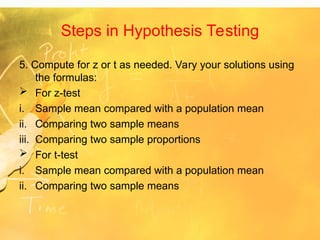
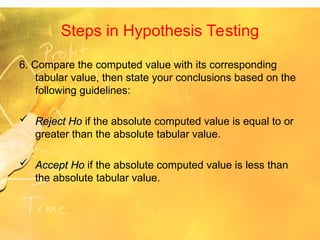

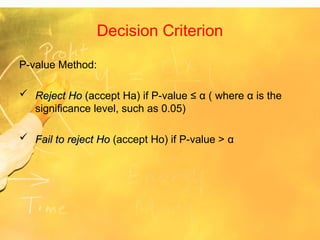

![Business Statistics for Managers with SPSS[1].pptx](https://ckxe7twkl7vq3ljkxejyz-s-a2157.bj.tsgdht.cn/ss_thumbnails/bsmwithspss1-240921045433-4aaea049-thumbnail.jpg?width=560&fit=bounds)










![BASIC CONCEPTS in STAT 1 [Autosaved].pptx](https://ckxe7twkl7vq3ljkxejyz-s-a2157.bj.tsgdht.cn/ss_thumbnails/basicconceptsinstat1autosaved-221027115944-55c11ebb-thumbnail.jpg?width=560&fit=bounds)


































